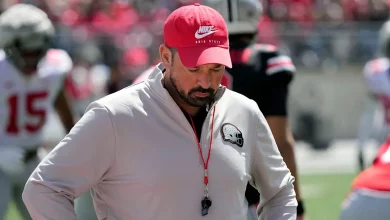Portal class demonstrates how LSU may change in 2025.

Portal Class Demonstrates How LSU May Change in 2025
The transfer portal has fundamentally altered the way college football programs approach team-building, and no program in the country has embraced this change more than LSU under head coach Brian Kelly. The LSU Tigers have long been known as a powerhouse in the SEC, with a storied history of success, including a 2019 national championship under former head coach Ed Orgeron. However, following a down period and a coaching transition, the program has leaned heavily on the transfer portal to revitalize its roster and compete at the highest level in the nation’s toughest conference.
As the Tigers gear up for the 2025 season, the influence of the transfer portal is expected to be more significant than ever. The 2024 portal class is shaping up to be one of the most important for LSU, as it promises to transform key areas of the team, most notably the offense, defense, and special teams. The impact of these portal additions could elevate LSU into national title contention once again.
In this article, we will break down how the Tigers’ transfer portal class of 2024 is influencing the team’s outlook for 2025, covering positional changes, key player additions, and what this influx of talent could mean for LSU’s chances in the SEC and beyond.
Brian Kelly’s Strategic Use of the Transfer Portal
When Brian Kelly took over as head coach of LSU in 2022, he inherited a program in need of an overhaul. The Tigers were coming off a disappointing season under Ed Orgeron, and their roster was full of question marks. One of Kelly’s first priorities was to build a championship-caliber team, and the best way to do that in today’s college football world is to take full advantage of the transfer portal.
Under Kelly, LSU’s use of the transfer portal has been strategic and targeted. Instead of relying solely on high school recruits, Kelly and his staff have dipped into the portal to bring in veteran players who can make an immediate impact. The success of this approach was evident in Kelly’s first season, as the Tigers were able to bring in quarterback Jayden Daniels from Arizona State, who immediately became a star and helped LSU win the SEC West. Other key portal additions, like Makai Wingo (defensive tackle) and Greg Brooks Jr. (defensive back), also made significant contributions.
For Kelly, the portal is not just a way to patch up weaknesses; it’s a means to build a deep, versatile roster capable of competing for championships. As we look ahead to the 2025 season, LSU’s transfer portal class of 2024 is set to play a pivotal role in the program’s rise to prominence.
Key Positional Changes and Portal Additions
With the 2025 season in mind, several key areas of LSU’s roster are undergoing significant changes, thanks to the transfer portal. The following are some of the most important positional shifts and player additions that will shape LSU’s 2025 team:
1. Quarterback: The Future of the Position
One of the most pressing questions heading into the 2025 season is who will lead LSU at quarterback. Jayden Daniels, who transferred to LSU from Arizona State ahead of the 2022 season, has been the Tigers’ starter and a dynamic playmaker for the past few years. However, Daniels’ eligibility will expire after the 2024 season, leaving LSU with a major need at the position.
In response, Brian Kelly has made an aggressive move in the transfer portal to bring in a potential starter for the 2025 season: Walker Howard, a highly regarded quarterback who transferred from Ole Miss. Howard, a former five-star recruit, was seen as one of the top quarterbacks in the 2024 class before choosing Ole Miss. However, after two seasons as a backup behind Jaxson Dart, Howard decided to transfer to LSU in hopes of securing the starting role.
Howard’s addition is a game-changer for LSU’s quarterback room. He is known for his arm strength, accuracy, and ability to make plays in the pocket and on the move. He also has the benefit of having learned under Lane Kiffin at Ole Miss, which has prepared him for the high-octane offense that Brian Kelly runs at LSU. Howard’s arrival brings competition to the position, and if he wins the starting job in 2025, LSU could have one of the most talented quarterbacks in the SEC leading its offense.
Additionally, LSU is bringing in several high-profile quarterbacks from the 2025 recruiting class, but Howard’s experience and skill set make him an immediate contender for the starting job. If he can step into the role and perform at a high level, LSU could see a seamless transition at quarterback without losing a step.
2. Defensive Line: Strengthening the Trenches
Another key area of focus for LSU is its defensive line. The Tigers’ defense has been solid in recent years but has lacked the elite talent in the trenches that is necessary to compete with the likes of Alabama and Georgia in the SEC. To address this issue, LSU has turned to the transfer portal to bring in several talented defensive linemen who can make an immediate impact.
One of the biggest additions is Jalen Lee, a defensive tackle who transferred from Florida State. Lee is a versatile and powerful interior defensive lineman who will immediately bolster LSU’s defensive front. He has the size (6-3, 310 lbs) to clog up running lanes and the athleticism to disrupt passing plays. Lee’s ability to control the line of scrimmage will be invaluable in stopping the run and applying pressure to opposing quarterbacks.
Additionally, LSU has added Mason Smith from Georgia Tech, a defensive end known for his pass-rushing ability. Smith’s addition gives LSU a much-needed boost on the edge, where the Tigers have lacked consistent pressure in recent years. His ability to get after the quarterback and disrupt offensive game plans will be crucial to LSU’s success in the SEC, where every team boasts a talented quarterback and strong offensive line.
The additions of Lee and Smith will help LSU improve its overall defensive depth, allowing for more rotation and fresher legs throughout the season. This enhanced defensive line should provide more opportunities for LSU’s linebackers and secondary to make plays, creating a more balanced and disruptive defense.
3. Secondary: Shoring Up the Back End
The LSU secondary has been a point of vulnerability in recent years, especially against high-powered passing offenses like those from Alabama, Mississippi State, and Ole Miss. In the transfer portal, LSU has found a pair of elite defensive backs who should help shore up this weakness and make the Tigers’ defense much more difficult to attack through the air.
First, LSU has added Tyrone Clark, a cornerback from Texas who was a standout player for the Longhorns. Clark brings size, speed, and ball skills to the Tigers’ secondary. At 6 feet 1 inch, he has the physicality to match up against taller receivers, and his ability to track the ball in the air makes him a potential difference-maker in pass coverage. His experience in the Big 12 will allow him to immediately contribute at a high level in the SEC.
Another key addition to LSU’s secondary is Malik Herring, a safety who transferred from Clemson. Herring is known for his hard-hitting style and ability to read the quarterback’s eyes. His coverage ability and physicality in the run game will allow LSU to play more aggressive in the secondary, particularly in situations that require forcing turnovers. Herring will bring leadership to a young and talented secondary, ensuring that LSU’s defensive backs are prepared for the challenges of facing SEC quarterbacks.
With the addition of Clark and Herring, LSU’s secondary should be much more capable of defending against explosive passing attacks. This will be a critical element for the Tigers if they are to compete with the high-scoring offenses in the SEC.
4. Wide Receiver and Running Back: Playmakers on Offense
On the offensive side of the ball, LSU has also been active in the transfer portal to strengthen its wide receiver and running back positions. The Tigers are looking to replace the explosive playmaking ability of players like Kayshon Boutte and John Emery Jr., who have left the program after standout careers.
LSU has added Eli Stowers, a wide receiver from Texas A&M, who brings size, speed, and a proven track record as a playmaker in the SEC. Stowers’ ability to stretch the field and make big plays in crucial moments will be vital to LSU’s success in 2025. He’ll be paired with returning stars like Malik Nabers and Jack Bech, forming one of the most dangerous receiving corps in the conference.
At running back, LSU has added Zachary Evans from Ole Miss, a highly regarded transfer who was one of the top players at his position in the SEC. Evans’ ability to break tackles, make defenders miss, and gain yards after contact will provide a balanced and potent offensive attack for the Tigers.









